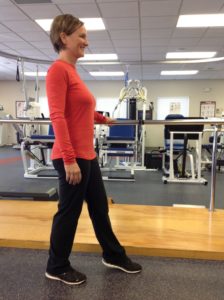Have you seen the V8 commercial where the personal trainer asks the client if they ate their vegetables today? When the client answers “no”, the trainer knocks him on the forehead as if to say “duh”. I had this kind of “ah-ha” moment with a client as we evaluated her balance training program. It went like this:
A healthy and fit woman in her early 50’s came into the gym for her weight workout. She happened to mention how poor her balance was – “look watch,” she invited as she stood on one leg, lasting no more than 2 seconds. Concerned about her declining balance, she always included balancing on one leg in her routine. No improvement was made. So basically she was telling me that she repeatedly tried the same exercise, saw no progress, but continued with hopes of better balance. I invited her to try something different.
Balance Training in 6-Directions
Balance exercises come in thousands of different varieties. Since the gym member was familiar with single leg balance, I used it as the basis for this exercise progression.
Exercise #1 – Pivot (for mobility)
Start position: Stand on one leg, holding a wall or railing with one hand
Action: Step the other leg in 6 directions
- Front and back (5-10x)
- Right and left (5-10x)
- Right and left rotation (5-10x)

Exercise #2 – Leg Swing (for stability)
Start Position: Stand on one leg, holding a wall or railing with one hand
Movement: Swing the suspended leg in the same 6 directions as exercise #1.
We performed exercises one and two on both sides of the body. Then we repeated the litmus test. Remarkably, her balance improved by 400% as she held a single leg balance steadily for an entire 8 seconds. You might be wondering, how could just 5 minutes of exercise have a stronger impact than the previous months of training?
Influences on Balance
To be honest, this exercise could have just as easily failed to yield any change at all. But, my rationale for exercise selection is rooted in truths of science. This balance example drew on the concept that stability begets mobility.
In a previous article, I explain why holding a stable surface helps improve balance. For this client, holding the wall, while performing the exercises provided a sense of stability, allowing for improved mobility, and leading to better balance.
Remember: your ability to move better is already inside you. All you’ve got to do is FEEL it.
Learn my follow-the-feel approach and get meaningful and lasting results from your workouts with me as your coach – join WECOACH Workouts.
